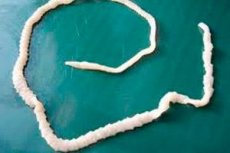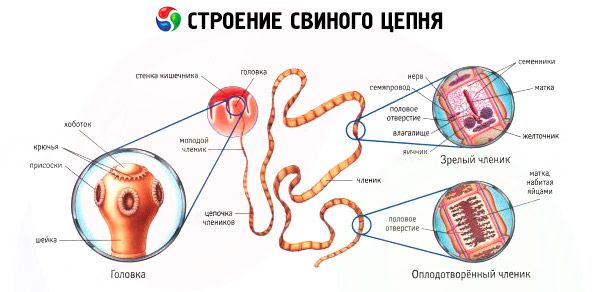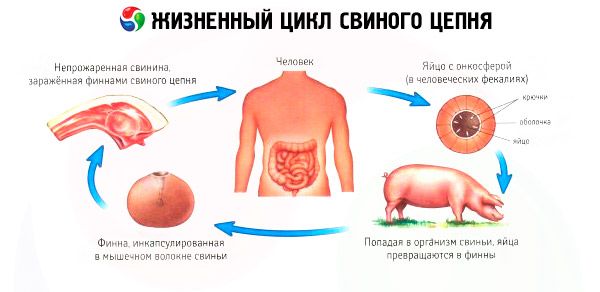Medical expert of the article
New publications
Swine tsetse in humans: characterization, symptoms, treatment and prevention
Last reviewed: 06.07.2025

All iLive content is medically reviewed or fact checked to ensure as much factual accuracy as possible.
We have strict sourcing guidelines and only link to reputable media sites, academic research institutions and, whenever possible, medically peer reviewed studies. Note that the numbers in parentheses ([1], [2], etc.) are clickable links to these studies.
If you feel that any of our content is inaccurate, out-of-date, or otherwise questionable, please select it and press Ctrl + Enter.

According to the classification of zoonotic parasites, the pork tapeworm (Taenia solium) is a cestode of the order cyclophyllidea of the family Taeniidae. This widespread intestinal worm is especially common in areas where people eat pork.
The diseases caused by this parasite are called taeniasis and cysticercosis, are classified as helminthiasis and have the ICD-10 code B68.0 and B69.
 [ 1 ]
[ 1 ]
Structure of pork tapeworm
Like all flatworms-parasites of the Taeniidae family, the structure of the pork tapeworm is a triploblastic acoelomate body type - a white tape up to two to three meters long that does not have a coelom (a fluid-filled cavity).
The elongated flat body of the pork tapeworm or strobila consists of a chain of segments (segments) - proglottids, the number of which ranges from 150-200 to 800-900. Each segment of the pork tapeworm is a full-fledged reproductive part.
At the anterior end of the worm there is a scolex with a diameter of 1 mm, which is connected to the strobila through a short neck. The scolex of the pork tapeworm has an organ of attachment to the wall of the host's intestine: four radially located round suckers, surrounded by a rostellum (nose), equipped with 22-32 chitinous hooks.
The entire body of the pork tapeworm is covered with a tegument, and its structure is unique in these cestodes. Since – due to the lack of internal cavities – these worms do not have digestive and excretory organs, the digestive system of the pork tapeworm, as well as the excretory system of the pork tapeworm, are located outside: the tegument is covered with an absorbent layer of tubular microvilli (microtriches). Each such microvilli has a plasma membrane covered with a glycocalyx consisting of proteoglycans (negatively charged polysaccharides).
Microvilli are the metabolically active organ of the pork tapeworm, simultaneously performing sensory, absorption, secretory and excretory functions. In addition, the glycocalyx is responsible for inhibiting the host's digestive enzymes and absorbing cations and bile salts. And the nutrients absorbed by the microvilli of the tegument penetrate into the tapeworm tissues by diffusion.

Habitat of pork tapeworm
The habitat of the pork tapeworm changes depending on the stage of its life cycle. At the egg stage, it lives in the animal's feces; oncospheres (larvae with an embryo) live in the intermediate host - in the muscle tissue and brain of a pig that has eaten waste with fecal particles. And the adult tapeworm lives in the intestines of the final host (humans).
The routes of infection with pork tapeworm are fecal-oral. Tapeworm infestation occurs when a person eats pork infected with larvae; other sources of infection are dirty raw vegetables and water, which may contain rejected segments of the pork tapeworm with a uterus filled with eggs or just eggs (which can survive outside the host for almost two months).
According to epidemiological data, the completion of the life cycle of this parasite occurs in those regions where people live in close contact with pigs and eat their undercooked meat. High prevalence rates are observed in Latin America, West Africa and sub-Saharan Africa, Eastern European countries, India, Pakistan and Southeast Asian countries. In countries where pork consumption is prohibited by Islam, taeniasis and cysticercosis are extremely rare.
Life cycle and reproduction of pork tapeworm
From the above it is clear that there is only one intermediate host in the pork tapeworm development cycle, and these are, as a rule, pigs (canines and humans can also be). And humans act as the only definitive host of the pork tapeworm.
The life cycle of the pork tapeworm includes several stages.
- The eggs of the pork tapeworm or morula, which contain embryonic larvae (oncospheres), enter the human intestine through the mouth and then through the gastrointestinal tract. When the eggs with embryos enter the intestine, mobile oncospheres equipped with hooks emerge from them through a “hatch”.
- The non-invasive larva of the pork tapeworm, the oncosphere, after emerging from the egg, attaches itself with hooks to the intestinal wall and then penetrates through the intestinal mucosa into the blood and lymphatic vessels, migrates to the striated muscles, brain and other tissues, where it settles, forming the next larval stage - cysticerci.
- The cysticercus of the pork tapeworm or the finna of the pork tapeworm is an invasive larva that forms from the oncosphere in about 70 days and can continue to grow for up to a year. At this stage, the larva has the appearance of a translucent, cloudy-white oval vesicle containing fluid and one invaginated protoscolex. Under the influence of bile and intestinal digestive enzymes of the host, the scolex protrudes outward, and thus the finna of the pork tapeworm is attached to the intestinal wall and begins to grow in size, using nutrients entering the small intestine of the host. Getting into the muscles and parenchyma of organs, the larva forms a cyst - a protective cuticular membrane.
- The adult worm, which develops from cysticerci within about 10-12 weeks after infection, lives in the human intestine. The strobila lengthens, and new proglottids are formed in the neck area, the growth zone of the worm. So the most mature and oldest proglottids are at the rear end of the body.
This parasite is a hermaphrodite, and the mature proglottid (pork tapeworm segment) has a complete bisexual reproductive set. The pork tapeworm reproduces through numerous testes and a three-lobed ovary, which open into common genital pores. The uterus of the pork tapeworm has 5-8 branches, but it is closed, that is, the eggs get out when the proglottids are rejected from the body of the cestode.
One proglottid can contain more than 50,000 eggs with embryos. Mature proglottids with pregnant queens often rupture in the intestines, releasing eggs that end up in the feces, and they are freely released into the environment with feces.

Symptoms of Pork Tapeworm Infection
The organs of humans affected by pork tapeworm are the small intestine, subcutaneous tissue, muscles, eyes, brain and spinal cord.
Invasion of the small intestine of humans by adult pork tapeworms causes taeniasis, which may be asymptomatic. However, symptoms of pork tapeworm infection in severe forms of infection include weight loss, loss or increase in appetite, anemia, abdominal pain, dyspepsia, nausea, constipation, and diarrhea.
Infection with pork tapeworm eggs (from which larvae emerge) or proglottids, which rupture in the intestines and can cause migration of larvae into human tissues with the formation of cysts (Cysticercus cellulosae), leads to the development of a systemic infection with clinical symptoms depending on the number, size and location of the cysts. Very often, symptoms of pork tapeworm infection in the larval stage may not appear for a long time. And when they do appear, doctors diagnose cysticercosis: pork tapeworm cysticerci, penetrating under the skin on the trunk and limbs, form subcutaneous cysts in the form of hard, mobile and often painful nodules.
The pork tapeworm can be found in any human muscle tissue, causing muscle inflammation (myositis) - with fever, eosinophilia and false muscle hypertrophy, which initiates swelling of the muscles with the threat of their atrophy and fibrosis. In most cases, this form of invasion occurs without obvious signs, since the cysticerci die and calcify.
In diagnosed neurocysticercosis, cysts formed by cysticerci (from 5-20 mm to 6-8 cm in diameter) are localized in the parenchyma or subarachnoid space of the brain. They can be numerous and life-threatening. Symptoms of pork tapeworm infection in cases of neurocysticercosis: headaches, dizziness, convulsions. The consequence of damage to brain structures can be a violation of their functions (sensory and motor), which causes epileptic seizures and such neurological pathologies as decreased cognitive abilities, hydrocephalus, meningeal syndrome, mental disorders.
If cysts form in the ventricles of the brain, the outflow of cerebrospinal fluid is blocked and signs of increased intracranial pressure appear: migraine-type headaches, nausea, sharp changes in blood pressure, sleep disorders, periodic hyperhidrosis, lethargy, increased fatigue, decreased hearing and vision. When the spinal cord is affected, chronic back pain appears.
Cysticerci can be found in the tissues of the eyeball and under the conjunctiva, causing retinal edema, hemorrhage, decreased vision or even loss of vision.
Diagnostics
Today, diagnostics of pork tapeworm infection in humans includes:
- analysis of feces for eggs and proglottids of the worm (can only detect taeniasis);
- blood test for antibodies to pork tapeworm (blood serum test using EITB – solid-phase immunoblotting);
- IF analysis of cerebrospinal fluid;
- X-ray or ultrasound of the intestine;
- X-ray of subcutaneous and muscle tissue (to identify calcified cysticercus larvae and confirm cysticercosis);
- computed tomography (CT) or magnetic resonance imaging (MRI) of the brain if neurocysticercosis is suspected;
- examination of the fundus and conjunctiva (in case of ophthalmic cysticercosis).
Differences between pork and beef tapeworms
The pork tapeworm has relatives – the cestode Taenia saginata (beef tapeworm) and the common in Asian countries Taenia asiatica (Asian tapeworm).
As parasitologists note, there are differences between pork and bovine tapeworms. First of all, they consist in the fact that the intermediate host of the bovine tapeworm is cattle; the bovine tapeworm is much larger in size (4-10 m in length), the proglottid uterus is more branched than that of T. solium, the ovary is two-lobed, and the scolex does not have a rostellum with hooks: instead of them, the worm T. saginata has only suckers.
In addition, the bovine tapeworm has a period of existence outside the hosts - in the environment (up to several weeks). When mature proglottids break away from the worm and end up in feces, they can crawl to a more suitable place - in the grass eaten by grazing livestock.
And the main difference: the beef tapeworm causes only helminthiasis of the taeniasis type, but does not cause cysticercosis and the more dangerous neurocysticercosis.
Differential diagnosis of infection with bovine and pork tapeworm is carried out using PCR analysis of blood serum.
As experts note, it is also important to differentiate neurocysticercosis from other pathologies of the brain (tuberculosis, tumors, etc.).
Treatment of pork tapeworm
Praziquantel (other trade names are Azinox, Biltrid, Biltricid, Cestox, Cystricid), Niclosamide (Phenasal, Cestocide, Gelmiantin) and Albendazole (Aldazole, Sanoxal, Vormil, Nemozol) are anthelmintic drugs used to treat pork tapeworm, in particular, taeniasis. To a lesser extent, cysticercosis, since calcification of larval cysts results in their involution, and antiparasitic therapy does not bring any benefit.
Praziquantel is taken once at a rate of 10 mg per kilogram of body weight. The drug is not used to treat children under 4 years of age and pregnant women. Side effects most often include nausea, vomiting, abdominal pain, bloody diarrhea, and dizziness.
The drug Niclosamide is prescribed to adults and children aged 12 years and over in 8-12 tablets (0.25 g); to children aged 6-12 years – 6 tablets; taken one hour before meals or two hours after meals; the tablets are chewed (or crushed into powder) and washed down with water. The duration of the course of treatment can be up to seven days.
Albendazole tablet (400 mg) is taken whole (after meals) once; for children, the dose is calculated at 6 mg per kilogram of their weight. For cysticercosis of the brain, 800 mg of albendazole is taken per day for 8-30 days. There may be side effects of the drug in the form of dyspepsia, abdominal pain, increased blood pressure, dizziness, changes in the level of leukocytes and platelets in the blood.
Forecast
The prognosis largely depends on the form and localization of the pathology that develops due to this helminthiasis. According to WHO, almost 400 thousand residents of Latin American countries have some symptoms of taeniasis and cysticercosis; in Mexico, these diseases affect about 3.9% of the population; in Guatemala, Bolivia and Peru - up to 20% (in pigs - up to 37%).
The rate of human infection with pork tapeworm in countries such as Ethiopia and Kenya is almost 10% of the population, and in Madagascar it is 16%.
According to global data for 2010, neurocysticercosis was the cause of death in 1,200 cases. In the United States, 221 people died from cysticercosis over 12 years (from 1990 to 2002); 62% of them were immigrants from Mexico, and, in all likelihood, they caught the pork tapeworm in their home country.

